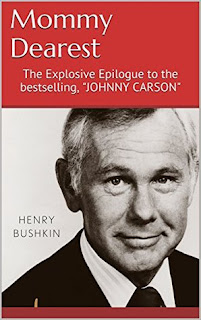 |
| Cover of the e-book Mommy Dearest, by Henry Bushkin, 2016. |
In April of 2016, Henry Bushkin released an epilogue to his
2013 memoir Johnny Carson. (I reviewed Bushkin’s memoir here.) The epilogue bears the cumbersome title Mommy Dearest: The Explosive Epilogue to the
Bestselling Johnny Carson. It’s only about 20 pages long, and it’s only been
released as an e-book. Mommy Dearest is
not very essential, but it was cheap and short, so I read it. Mommy Dearest explores the relationship
between Johnny Carson and his mother, Ruth Carson. Just about everyone who has
written about Johnny Carson has come to the conclusion that much of Carson’s
personality can be traced back to his difficult relationship with his mother,
who never gave him the love and acceptance he wanted.
In Mommy Dearest Bushkin
writes, “There’s not a single factor that contributed more to Johnny’s dislike
towards women (and lack of real attachment to other people) than his own
mother, Ruth Carson.” In Mommy Dearest, which
was written with Dr. Arthur Malin, Bushkin diagnoses Carson as suffering from
Narcissist Personality Disorder, or NPD. Was Carson a narcissist? Perhaps, but
it might also be true that being a huge celebrity for many years made him a
narcissist. In Johnny Carson, Bushkin
tells a story about Carson throwing a fit when his room wasn’t ready at the Las
Vegas hotel he was performing at. Sure, Carson was more annoyed than he should
have been, but when do you think the last time Johnny Carson had to wait more
than 5 minutes for anything was? Probably 1958. If you’ve had everything handed
to you on a silver platter for decades, why would you have any patience? Jeanne
Prior, Carson’s secretary during the 1960’s, said of him: “Except for the
beginning years of his life, I don’t think Johnny has ever been rejected. Just
think of the fact of going around for thirty years and never being rejected by
almost anybody, not waiters, not anybody. What do you think would be easier to
live with, his life or the life most of us live? There is a cost, and that’s
why he insulates himself.” (King of the
Night, by Laurence Leamer, p.160) I’m not trying to defend Carson’s
behavior, but put it in a broader context. In general, I think it’s difficult
for celebrities to keep in touch with the real world, and latent tendencies in
their personalities can bloom once they have wealth and power.
Bushkin goes on to compare Carson to other Hollywood
narcissists like Charlie Sheen and Alec Baldwin, which adds to the page count,
but doesn’t really add anything to the narrative. It isn’t really “explosive,”
since Carson’s difficult relationship with his mother has been well documented
in other books, including Bushkin’s first book. It seems as though the only
reason Mommy Dearest exists is
because Bushkin suddenly realized that Johnny Carson was a narcissist, which
seems obvious from reading Bushkin’s first book about his boss.
Overall, Mommy Dearest
is an inessential sequel that doesn’t add very much to the canon of books
about Johnny Carson.







